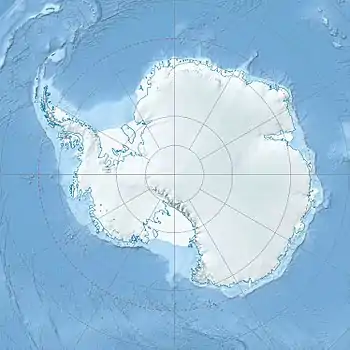Mount Haddington
Mount Haddington is a massive 1,630 m (5,350 ft) high shield volcano comprising much of James Ross Island in Graham Land, Antarctica. It is 60 km (37 mi) wide and has had numerous subglacial eruptions throughout its history, forming many tuyas. Some of its single eruptions were bigger in volume than a whole normal-sized volcano.[3] Old eruption shorelines are widespread on the volcano's deeply eroded flanks.
| Mount Haddington | |
|---|---|
 Mount Haddington | |
| Highest point | |
| Elevation | 1,630 m (5,350 ft)[1] |
| Prominence | 1,630 m (5,350 ft)[1] |
| Listing | Ultra |
| Coordinates | 64°13′S 57°38′W[1] |
| Geography | |
| Location | James Ross Island, Antarctica |
| Geology | |
| Mountain type | Shield volcano |
| Volcanic field | James Ross Island Volcanic Group |
| Last eruption | Unknown[2] |
Haddington formed along the Larsen Rift dominantly during the Miocene and Pliocene epochs but more recent eruptions have produced tuff cones on its slopes. The youngest tuff cones and pyroclastic cones on the eastern slope are situated below the summit icecap and may have formed in the last few thousand years. Effusive eruptions have created large deltas composed of hyaloclastite breccia and lava flows.[2]
Mount Haddington was discovered on December 31, 1842 by the Ross expedition, a voyage of scientific exploration of the Antarctic from 1839 to 1843 led by James Clark Ross. Ross named the mountain after the Earl of Haddington, then First Lord of the Admiralty.[4]
References
- "Antarctica Ultra-Prominences" Peaklist.org. Retrieved 2012-09-04.
- "James Ross Island". Global Volcanism Program. Smithsonian Institution. Retrieved 2018-01-14.
- Antarctic Volcanoes: Antarctic volcanoes punching holes in the ice Retrieved on 2007-11-11
- "Mount Haddington". Geographic Names Information System. United States Geological Survey, United States Department of the Interior. Retrieved 2018-01-17.